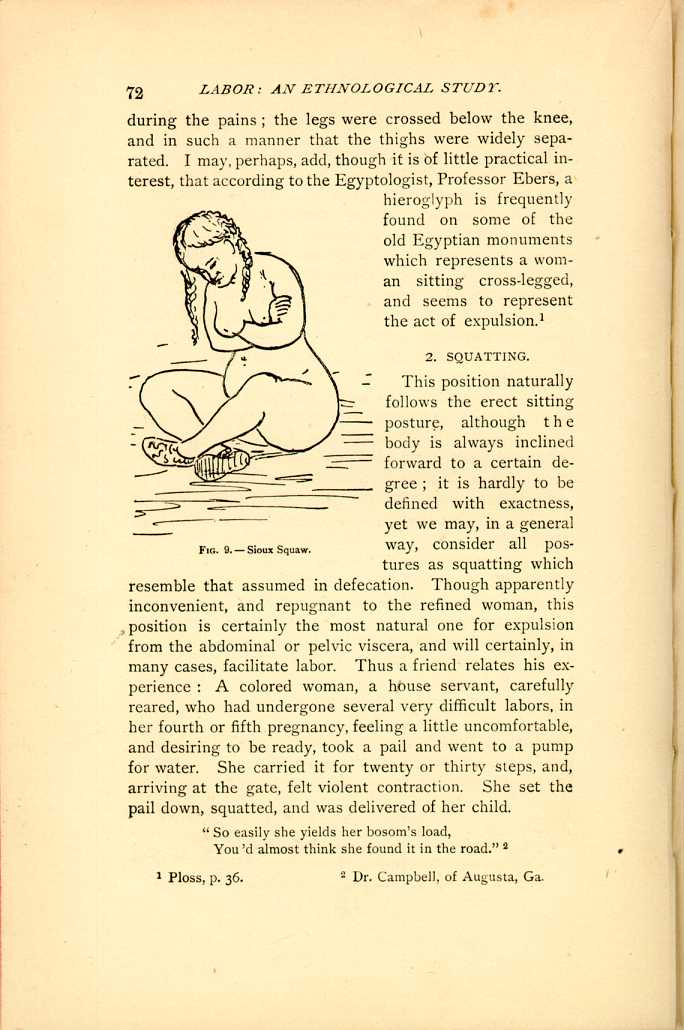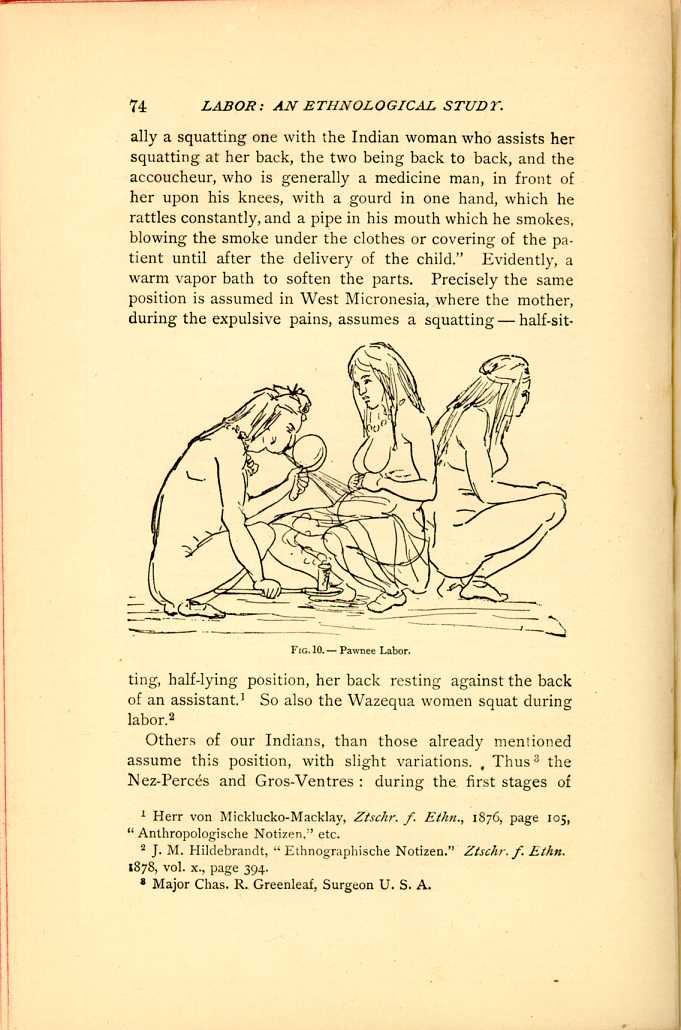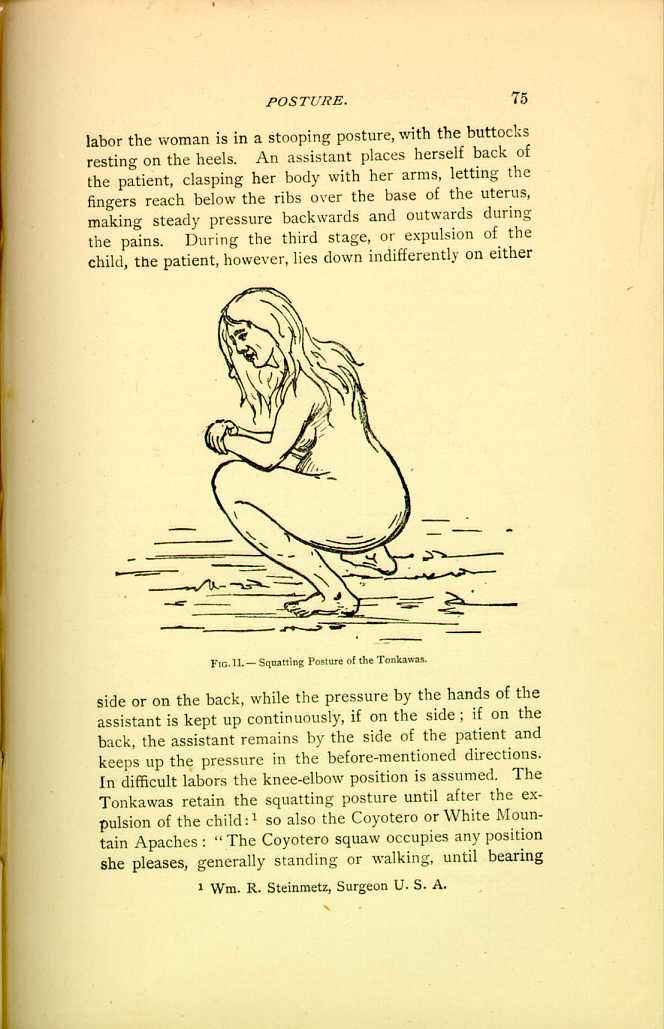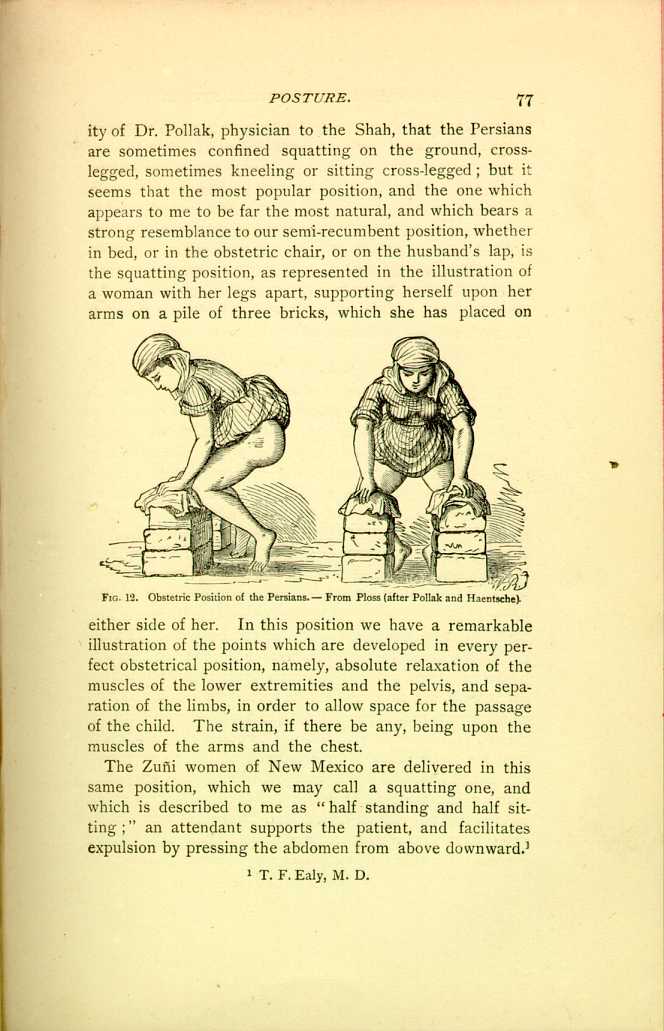| CHAPTER II.
POSTURE IN LABOR. Labor Among Primitive Peoples | ||
2. SQUATTING.
This position naturally
follows the erect sitting
posture, although the
body is always inclined
forward to a certain degree;
it is hardly to be
defined with exactness,
yet we may, in a general
way, consider all postures
as squatting which

FIG. 9.—Sioux Squaw.
[Description: Pregnant woman sits cross-legged. Black and white
illustration.]
"So easily she yields her bosom's load
You'd almost think she found it in the road.''[32]
Then, again, he tells me of attending a lady of good position in society in two labors. "In her first labor, delivery was retarded without apparent cause. There was nothing like impaction, or inertia, yet the head did not advance. At every pain she made violent efforts, and would bring her chest forward. I had determined to use the forceps, but just then, in one of the violent pains, she raised herself up in bed and assumed a squatting position, when the most magic effect was produced. It seemed to aid in completing delivery in the most remarkable manner, as the head advanced rapidly, and she soon expelled the child by what appeared to be one prolonged attack of pain. In subsequent parturition, labor appeared extremely painful and retarded in the same manner; I allowed her to take the same position, as I had remembered her former labor, and she was delivered at once, squatting.''
The Irish, also, are familiar with this most natural of all positions, although the knee-elbow position is more common among them. A striking instance is related to me of a poor Irish woman who was found upon a vacant lot in New York city, squatting upon the ground, endeavoring to express the placenta, the child having already been delivered in the same position.[33]
Dr. John Williams, physician to the Green Bay Indian Agency, seems to consider with great favor this position as assumed by the Pawnee Indians. He has had extensive experience as Agency physician, having been associated with different tribes of Indians in different localities, and he does not think that climate has anything to do with the labor of the parturient woman. He says: "I am satisfied that the Pawnee Indian women are far more exempt from the maladies resulting from parturition than the Menemonee, Stockbridge, or Oneidas of Wisconsin. Possibly this may be attributed to the position assumed during labor. The position of the Pawnee woman in parturition is generally

FIG. 10.—Pawnee Labor.
[Description: Medicine man rattles gourd and blows pipe smoke towards abdomen of squatting pregnant woman. Another woman squats nearby. Black and white illustration.]Others of our Indians, than those already mentioned assume this position, with slight variations. Thus[36] the Nez-Percés and Gros-Ventres: during the first stages of

FIG. 11.—Squatting Posture of the Tonkawas.
[Description: Pregnant woman in squatting position. Black and white illustration.]A slight variation of this position is found among some of the larger branches of the Sioux Nation, the Brulé, Loafer, Ogallala, Wazahzah, and Northern, who stoop, and with their hands grasp deer-thongs attached to stakes driven into the ground, against which they pull.[39]
The Mexican half-breeds, in New Mexico and vicinity, sometimes suspend a cord from the ceiling, with a stick attached, so that the women can seize it in a half-upright, squatting position.[40] The same we find among the Kalmucks upon the borders of China and Russia, and not unfrequently during the third stage of labor they squat lower in bed on their heels, whilst holding with their hands on to a pole, the abdomen being pressed from behind by an assistant.[41]
The squatting position, with the body bent forward, is assumed by the women of Southern Arabia in the vicinity of Aden, who, however, rest their hands upon the ground instead of crossing them upon the breast, as the squaw does. But, among these people, as among so many of our Indians, and the tribes of Africa, massage is freely resorted to if any obstruction seems to prevent the labor, sometimes with the hands, sometimes with the feet; in the latter case, the assistant, standing with her heels upon the lower ribs, works the fundus of the uterus with her toes.[42]
Every people varies its customs a little. The Polynesian and Australian negresses squat, as in defecation, over a small hole which they have scratched in the ground for the reception of the child.[43] Ploss also states, upon the authority

FIG. 12. Obstetric Position of the Persians.—From Ploss (after Pollak and Haentsche).
[Description: Front and side view of a pregnant woman supporting herself in a squatting position by placing her hands of stacks of bricks on either side of her. Black and white illustration.]The Zuñi women of New Mexico are delivered in this same position, which we may call a squatting one, and which is described to me as "half standing and half sitting;'' an attendant supports the patient, and facilitates expulsion by pressing the abdomen from above downward.[44]
In the neighboring Laguna Pueblo pretty much the same custom is followed. In the early stages of labor the patient stands, as she urinates, with her hands on her knees; later, she stands up, supported by a woman on each side, or a rope is cast over a joist of the roof and allowed to hang down in a wide loop; she puts her breast in the loop and holds on to the ascending ropes, her feet on the floor, in a half-sitting (squatting) posture, thus obtaining great expulsive force; if tired and worn, she lies down. All these positions are assumed at the choice of the patient or the advice of her assistants, two to six in number.[45]
| CHAPTER II.
POSTURE IN LABOR. Labor Among Primitive Peoples | ||